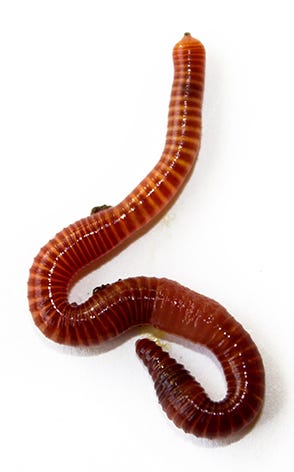Red worms: Composting made easy
Red worms: Composting made easy
Blog Article
The Ultimate Guide to Red Wigglers for Healthy Soil
The role of red wigglers, clinically understood as Eisenia fetida, in soil health and wellness is a subject of enhancing rate of interest among sustainable gardening enthusiasts and agricultural specialists alike. These organisms not only reuse organic waste yet additionally improve dirt fertility with their nutrient-rich spreadings.
What Are Red Wigglers?
Red wigglers, clinically called Eisenia fetida, play an important function in composting and soil health. These earthworms are particularly well-suited for vermicomposting, a procedure that uses their natural behaviors to decompose natural matter efficiently. Unlike other earthworm species, red wigglers grow in abundant organic settings, making them ideal for garden compost bins and worm farms.
Measuring about 3 to 4 inches in size, red wigglers have an unique reddish-brown coloration and a fractional body that helps in their wheelchair via rotting materials. They are detritivores, meaning they prey on rotting natural substances, consisting of kitchen scraps, plant particles, and paper items. red worms. Through their intake of these materials, they assist break down intricate substances, turning them right into nutrient-rich castings that improve soil top quality
Red wigglers are also respected breeders, qualified of recreating promptly under optimum problems. Their flexibility to different settings allows them to prosper in a variety of composting systems. By recognizing the biology and ecological significance of red wigglers, gardeners and farmers can harness their abilities to improve dirt health and promote sustainable techniques in agriculture.

Advantages of Red Wigglers
The countless benefits of incorporating red wigglers right into composting techniques significantly improve dirt wellness and fertility. These earthworms, scientifically known as Eisenia fetida, stand out at damaging down natural issue, transforming kitchen area scraps and yard waste right into nutrient-rich vermicompost. This process not only speeds up disintegration yet also enhances the dirt with important nutrients such as nitrogen, phosphorus, and potassium.
Moreover, red wigglers enhance dirt structure by producing accumulations that facilitate aeration and water retention. Their burrowing activities advertise a well-aerated setting, allowing roots to gain access to oxygen extra efficiently. This boosted aeration also cultivates useful microbial activity, which is crucial for nutrient biking and overall soil vigor.
Along with boosting soil composition and structure, red wigglers add to pest management. Their presence in the soil assists reduce harmful nematodes and other bugs, lowering the demand for chemical treatments. In addition, the application of vermicompost brings about increased plant strength against conditions, advertising much healthier growth.
Establishing a Worm Bin
Setting up a worm bin can be a rewarding undertaking for those wanting to boost their composting initiatives. The very first step is picking a suitable container, preferably made from plastic or wood, with a capability of a minimum of 10 gallons to accommodate the worms and their food. Ensure the bin has appropriate air flow-- pierce little holes in the lid and sides to promote air movement while preventing excess moisture build-up.

Present the red wigglers right into the bin, enabling them to adapt to official statement their brand-new setting. Ideally, begin with a population of concerning one extra pound of worms per square foot of surface area. Finally, place the worm bin in a location that keeps a stable temperature level, preferably in between 55 ° F and 77 ° F. With these fundamental actions, your worm container will certainly be prepared to grow in the search of healthy soil.
(red wiggler worms for sale near me)
Feeding Your Red Wigglers
When it comes to nurturing red wigglers, recognizing their dietary requirements is important for keeping a healthy worm bin. These worms prosper on a varied diet regimen, primarily composed of organic matter.
Portion control is vital; overfeeding can result in smell concerns and attract insects. A good general rule is to provide food that is approximately equivalent to the weight of the worms in the container each week. Screen the intake price and readjust feeding amounts appropriately.
To promote a well balanced diet regimen, goal to provide a mix of nitrogen-rich environment-friendlies, such as veggie peels, and carbon-rich browns, such as dried out fallen leaves or cardboard. In addition, maintaining appropriate wetness levels is essential-- food scraps ought to be moist however not soggy - red worms. By very carefully handling their diet and setting, you will certainly make certain that your red wigglers continue to be healthy and balanced and efficient, contributing effectively to the composting process
Using Worm Spreadings in Soil
Integrating worm castings right into dirt can considerably enhance its health and fertility. Worm castings, additionally referred to as vermicompost, are an abundant source of nutrients, including nitrogen, phosphorus, and potassium, necessary for plant development. When contributed to soil, these castings enhance its framework by increasing oygenation and enhancing wetness retention, which is particularly advantageous in deserts.
Additionally, worm spreadings introduce valuable microbes that promote a healthy and balanced dirt environment (red worms). These microbes help in damaging down raw material, making nutrients quicker available to plants. The presence of these microbes additionally assists suppress soil-borne conditions, minimizing the need for chemical fertilizers and pesticides
To utilize worm castings successfully, mix them into the leading few inches of dirt before planting or use them as a top clothing around developed plants. A recommended application rate is concerning 10-20% castings blended with soil to enhance vitamins and mineral schedule without overwhelming the plants.
Verdict
In conclusion, red wigglers, or Eisenia fetida, play a pivotal function in improving dirt health via their vermicomposting activities. By converting natural waste right into nutrient-rich castings, these worms enhance dirt framework, aeration, and dampness retention. Effective administration of their habitat and nutritional needs optimizes their advantages in horticulture techniques. Ultimately, the integration of red wigglers into dirt administration strategies promotes sustainable farming by lowering dependence on chemical fertilizers and fostering useful microbial task.
Report this page